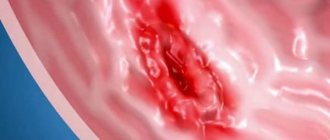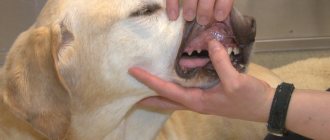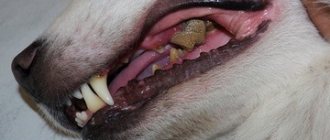Gastritis is an inflammation of the mucous membranes of the stomach. This pathology occurs quite often. Don’t worry too much; if you consult a specialist in a timely manner, the inflammation will go away very quickly.
If no measures are taken to improve the pet’s condition, the inflammation can spread further along the digestive tract. For example, gastroenteritis develops - inflammation of the mucous membranes of the stomach and intestines.
The causes of this disease are similar to those in humans, and among humans this disease occupies a leading place, so you have probably heard about it.
Causes of gastritis
In humans, the main cause of gastritis is the bacteria Helicobacter pylori, but in dogs there is no direct connection between the presence of these bacteria in the stomach and the development of inflammation.
The stomach of healthy animals is inhabited by Helicobacter - a wide range of acid-fast bacteria.
Inflammation of the stomach in dogs can develop for several reasons:
- Feeding disorders. This could be poor quality food, missing products, or simply “food from the table,” i.e. fried, smoked, fatty, etc.
- Food intolerance or allergy. Inflammation of the stomach is one of the consequences of these disorders in the body.
- Oral diseases/dental problems.
- Foreign bodies. This body could be a bone, or it could be something that is not even remotely edible. A foreign body can get stuck in the stomach itself and lower in the intestines. It (or they, if there are several of them) disrupts the patency of the digestive tract or can injure the gastric mucosa, which causes inflammation.
- Poisoning with toxic substances.
- Infestation by parasites. Some helminths live just on the gastric mucosa. They stick to it, release toxins and irritate the walls of the organ.
- Viral infection.
The above factors directly affect the development of inflammation in the stomach, but there are also secondary causes - diseases of a different nature (sometimes of completely different organs and systems), which one way or another can cause gastritis:
- Infectious diseases.
- Liver or kidney diseases.
- Stress.
- Injury.
- Hormonal disorders, such as hyperadrenocorticism or diabetes mellitus.
Gastritis in dogs
Gastritis in dogs is inflammation or simply irritation of the gastric mucosa, one of the most common diseases of the gastrointestinal tract.
Gastritis in dogs is inflammation or simply irritation of the stomach mucosa, one of the most common diseases of the gastrointestinal tract. Gastritis can be acute or chronic and in any case causes discomfort for the dog, although it is relatively easy to treat. It develops at any age and in all breeds.
Inflammation occurs for many reasons. The most common are a violation of the diet, low-quality food (for example, food from the owners’ table, often spicy, fried or too fatty), ingestion of an inedible object, or poisoning from waste. In some cases, gastritis only accompanies a systemic disease of the gastrointestinal tract.
There are no specific signs of gastritis in a dog; many symptoms are similar to simple poisoning or other similar diseases. In general cases, the dog is observed to vomit, and a little less often - diarrhea. The animal refuses to eat, whines, and behaves restlessly.
Gastritis
This is inflammation or irritation of the stomach lining. Gastritis can occur as a result of an animal ingesting substances that damage the stomach wall, such as grass, bones, foreign bodies or poor-quality feed. In addition, gastritis in dogs and cats can occur as a secondary disease against the background of a bacterial, viral or parasitic infection. Another quite common reason for the development of gastritis is the use of medications such as aspirin, antibiotics and steroids.
Acute gastritis most often goes away on its own within two to three days, but if the symptoms are observed for a longer period of time, then this condition in the animal can become chronic.
The main clinical signs of acute gastritis are:
- vomiting (there may be secondary vomiting of a foamy consistency, yellow in color)
- loss of appetite
- pain in the abdominal area
- diarrhea
- fever and weakness if the cause is a viral or bacterial infection.
When making a diagnosis, doctors at the Zovet Veterinary Center are based on clinical signs, blood and stool tests. If necessary, an X-ray examination of the gastrointestinal tract or gastroscopy is performed.
Treatment of gastritis depends on the general condition of the animal and the stage of the pathological process. The main preventative measures are proper, nutritious feeding.
Symptoms
No matter what causes the inflammation of the gastric mucosa, if the process is acute, the symptoms are always similar.
The pain is usually not that severe. The first thing owners notice:
- Vomit. Usually it occurs suddenly, maybe with an admixture of bile or mucus, or even less often with an admixture of blood (due to bleeding in the stomach).
- Diarrhea. It may also be mixed with blood due to stomach bleeding.
- Conversely, there may be constipation. If the stool is dark, it means there is blood in it.
- General depression.
- Lack of appetite (not always, but may be the only sign!).
- When palpating the abdominal wall in the stomach area, the dog experiences pain. She herself will not tell you this, you can understand it by her behavior. She may start to growl or whine, depending on the animal's temperament. Even if your dog is silent like a guerrilla, pain can be recognized by the tension in the abdominal wall.
- Vomiting often occurs in the morning or immediately after eating, depending on whether the acidity in the stomach is high or low.
Symptoms of gastritis in a dog
The most common symptom of gastritis in dogs is vomiting.
The most common symptom of gastritis in dogs is vomiting. It occurs due to the fact that the irritated pancreas is unable to properly process food.- In acute gastritis, vomiting can last more than a week. The dog refuses to eat, loses weight, and looks depressed. Vomit mixed with mucus and sometimes bile.
- A white coating is visible on the tongue, and soreness is noted in the stomach area.
- The body temperature may be elevated, and the stool may be thin and dark.
- With chronic gastritis, the temperature often does not rise, but the animal loses weight, eats poorly, sometimes vomits, liquid feces, and the mucous membrane of the eyes is jaundiced for no apparent reason. It is not uncommon for a dog to vomit yellow mucus after eating grass.
This form of the disease can last for years.
To confirm the diagnosis, fluoroscopy of the stomach and examination of its contents are necessary.
Diagnostics
Gastritis is an easy disease to diagnose and treat. If you take the necessary measures in time.
The cause of the developed inflammation cannot always be determined, but this is not particularly important, except in cases of parasites or a foreign body.
Since the mild stage of gastritis is treated symptomatically, the primary diagnosis can be based on anamnesis (data about life, feeding, treatments and vaccinations, which the doctor learns from the owner) and on a physical examination.
Physical examination includes external examination of the animal, palpation and auscultation of the painful area.
If, based on the data obtained, the veterinarian does not see signs of systemic diseases and there is no severe abdominal (abdominal) pain, signs of obstruction or the presence of a foreign body, and he suspects gastritis, then symptomatic therapy and a special diet are prescribed. Often this is enough for the stomach to return to normal.
If after 2 days of such therapy the pet’s condition does not improve, it is necessary to conduct a full comprehensive examination in order to prescribe a full-fledged high-quality treatment!
For a high-quality diagnosis, the dog must endure a starvation diet. In situations where the dog has not eaten for more than two days, he is prescribed maintenance therapy in the form of nutritional drips.
If a foreign body or obstruction is suspected, they are sent for an X-ray with contrast (preliminary barium is removed).
Next, blood and urine are taken for laboratory tests.
If necessary, ultrasound diagnostics of the abdominal cavity is performed.
The most informative research method is gastroscopy. It is carried out using a special device - an endoscope. Unfortunately, it is not available in all veterinary clinics. If you don’t go into details, then with its help it is possible to directly see the changes occurring in the stomach and even remove some small tumors.
What and how to treat
If the diagnosis has been confirmed and the dog actually has gastritis, treatment always begins with a starvation diet and further correction of the diet (see below). If a helminthic infestation is suspected, unscheduled deworming in therapeutic doses is mandatory. Treatment of gastritis in dogs at home is allowed with the permission of a veterinarian and strictly according to his instructions. Independent attempts to eliminate the pathology can lead to its progression, up to gastric ulceration.
We recommend reading: Description of the ostrich and its varieties: appearance, weight and height
Treatment includes the following medications (all combinations, frequency of administration and course duration are determined only by a veterinarian!):
| Antiemetics, prokinetics |
|
| Secretion inhibitors |
|
| Enveloping drugs (dosages are selected individually, taking into account the dog’s weight and the course of the disease) |
|
| Antibiotic therapy in case of secondary bacterial infection (all drugs are taken for a minimum course of 14 days, maximum 21 days) |
|
| Anti-inflammatory drugs for allergic reactions | glucocorticosteroids (at the discretion of the attending physician): 0.5-1 mg/kg in terms of prednisolone 1-2 times a day in an individual course |
| Antispasmodics |
|
| Enzymatic preparations for impaired digestion of feed |
|
Types of gastritis
Inflammation in the stomach can be acute or chronic.
Acute gastritis is characterized by sudden severe vomiting and rapid development with increasing pain.
Chronic gastritis is a consequence of the acute stage. Usually in such cases, periodic vomiting continues for more than a week and then significant weight loss becomes noticeable.
According to the form they are distinguished:
- Erosive ulcerative gastritis. This form differs in that ulcers form on the gastric mucosa.
- Eosinophilic, lymphoplasmacytic and granulomatous gastritis - these forms are not clinically distinguished; they are differentiated only on the basis of histological (tissue) analysis. They are characterized by thickening of the stomach wall and increased levels of eosinophils. Usually caused by a parasitic infestation or an allergic reaction/food intolerance.
- Atrophic gastritis (it occurs chronically) is characterized by thinning of the walls of the stomach and atrophy of the gastric glands.
- Separately, it is worth highlighting chronic hypertrophic gastropathy . This form of pathology leads to disruption of gastric outflow and is characterized by severe vomiting immediately after eating for several days.
Gastric volvulus with gastritis in a dog
Stomach overflow, otherwise known as gastric dilatation, can quickly kill a dog without any apparent reason
Stomach overflow, otherwise known as gastric dilatation, can quickly kill a dog without any apparent reason. Large dogs with deep chests most often suffer from this. Typically, before becoming ill, these dogs eat a large meal, drink large amounts of water, and exercise vigorously for two to three hours after eating. Their stomach, filled with gas and/or fluids, may become twisted.
Signs of acute gastric dilatation include extreme restlessness, salivation, and unsuccessful attempts to vomit. The abdomen becomes very bloated. Depending on the duration of this condition, the dog may go into shock. To save the dog, immediate surgery is required to decompress the stomach and correct the volvulus by restoring the stomach to its original position.
The pathogenesis of gastric volvulus in carnivores consists of several stages that manifest their effects on different organs and organ systems of the dog. These stages can be roughly divided into:
- primary filling of the stomach with gases due to the onset of fermentation processes and spasms of the pyloric and cardiac parts of the stomach (gastrectasia)
- twisting of the stomach and spleen around the esophagus and gastrosplenic ligament (actually gastric volvulus);
- hemodynamic disturbances in the aorta, hepatic portal vein and caudal vena cava, increased pressure in the abdominal and thoracic cavity;
- disturbances of water and electrolyte metabolism, hypoxia, hypovolemia, increased toxicosis and death.
Treatment
- First of all, if the cause of inflammation is established, then it must be eliminated. For example, if gastritis is caused by any drug, then under the supervision of a veterinarian you need to stop it (and prescribe a harmless analogue). If the cause is helminthic infestation, then it is worth deworming.
- Next, the pet is prescribed a starvation diet for several hours so that the gastrointestinal tract “rests.”
- Resume feeding gradually. They give food often, but in small portions.
- It is very important to change feeding. We are not returning the previous diet. The veterinarian must prescribe a special diet.
- If necessary, infusion therapy is prescribed (droppers or subcutaneous administration of drugs). This is necessary if the animal is dehydrated.
- Next, at the doctor’s discretion, gastroprotectors are prescribed (most often sucralfate). They may also prescribe medications that stimulate peristalsis (stomach motility).
- In some cases, prednisolone is prescribed (here you need to be very careful with the dosage; you should not give it without the supervision of a veterinarian).
- The duration of treatment depends on the severity of the disease.
In any case, you need to understand that if a dog has once been diagnosed with gastritis, most likely the tendency to it will haunt the dog for the rest of its life. So be careful about feeding your pet.
All medications must be prescribed by a specialist; you should not resort to self-medication.
Diet for gastritis
It all depends on whether you feed your dog natural food or dry food. When choosing dry food, you should pay attention to the Gastro medicinal line. Royal Canin has such lines.
If your dog sits on a natural bed, it will be more difficult. Ideally, you need to contact a veterinary nutritionist so that he can create a balanced therapeutic diet specifically for your pet.
If this is not possible, then the main thing is to adhere to several rules:
- Eliminate all fatty meats. It is better to leave only rabbit or turkey meat.
- Cook porridge separately from meat.
- Do not give your dog meat broth - it is too fatty.
A good option would be boiled rice with low-fat cottage cheese. However, not every dog will agree to eat it.
Prevention
Even if your dog is not included in the breed risk group, it is still important to prevent the development of gastritis. For this:
- The dog's diet must be balanced and consist of approved foods.
- Do not feed your pet “from the table”. Even if he asks. Find recipes for healthy dog treats or buy ready-made ones at a pet store if you want to please your pet.
- Annual vaccinations and periodic treatments against worms are the basis for the prevention of many diseases.
- It is important to monitor not only the correctness of the diet, but also the size of portions.
- Regular oral hygiene. Here we are not even talking about the fact that dogs also need to brush their teeth (which, of course, is very important). It is necessary to at least regularly examine your pet’s mouth, and if you notice any changes, such as inflammation of the gums, tooth loss or tartar formation, then you need to take the dog to the veterinary clinic for oral sanitation.
Don't forget that the mouth is part of the digestive tract.
Briefly about the main thing
Gastritis is a common inflammatory disease of the stomach.
- There are many reasons for the development of inflammation, both directly leading to gastritis and through other diseases. The most common: improper feeding, poisoning with toxins or other drugs, eating plants, allergies or food intolerances, helminthic infestations, viral infections, foreign body in the stomach, trauma, stress, genetic predisposition, gastritis can be immune-mediated.
- Main symptoms: refusal to eat and sudden vomiting.
- Diagnosis must be carried out in a veterinary clinic. The diagnosis is made based on the data that the animal owner must provide (information about feeding, treatments, vaccinations and recent activity) and clinical research methods. Sometimes additional diagnostics are performed (fluoroscopy, ultrasound diagnostics, gastroscopy).
- Treatment depends on the stage of inflammation and the general well-being of the dog. All medications must be prescribed by a veterinarian; you should not self-medicate.
- Some dogs have a genetic predisposition to certain forms of gastritis.
What is gastritis
Gastritis is an inflammation of the stomach lining. The pathology causes considerable discomfort. During the acute stage, the pet suffers from pain. The disease can be acute or chronic. Gastritis in dogs provokes disturbances in the secretion of gastric composition. Also, depending on the type of disease, the chemical composition of gastric juice changes.
Types of gastritis in dogs
Types of gastritis in dogs
- Hyperacid The acidity of gastric juice increases.
- Hypoacid In this case, the acidity varies within neutral.
- Anacidic This is the most severe and rare form of gastritis, which is characterized by complete indigestion of food, since the secretion does not contain hydrochloric acid and enzymes.
- Erosive Characterized by a large number of erosions that affect the gastric mucosa. The reasons for the development of this form of gastritis are not fully understood, but experts suggest that the most likely cause of erosive processes is stress. Dogs living in urban areas are at risk. Also, erosive gastritis can be a consequence of intoxication of the body, including medications.
- Eosinophilic gastritis A form of gastritis, during which there is a significant thickening of the walls of the stomach, while connective tissue appears, in which eosinophils predominate. These blood cells perform a protective function by neutralizing parasites. The most likely cause of eosinophilic gastritis is worms.
- Atrophic gastritis This form of the disease is characterized by a decrease in the thickness of the stomach walls. Some breeds of Laika dogs are at risk.
Most often, gastritis develops in older dogs who lose the ability to chew food thoroughly. It is much less commonly diagnosed in puppies.
Painful sensations can be periodic and bother the pet throughout its life, or it can be caused by a specific situation.
Causes of gastritis in dogs










